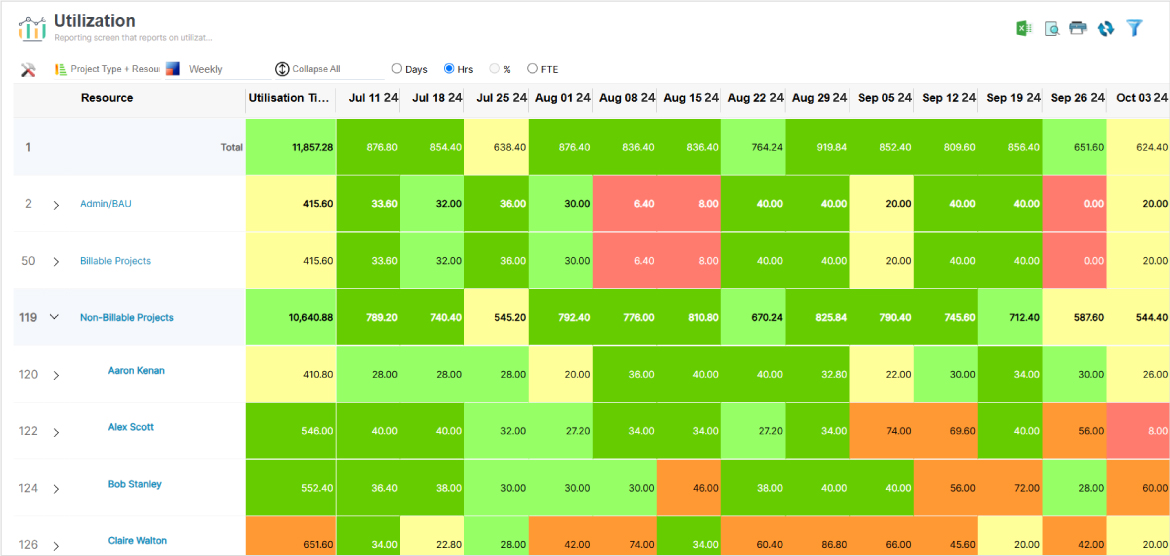A recent Statista survey revealed that, “The employee billable utilization at professional services firms worldwide stood at just over 69 percent.”
This highlights that around 31% of employees’ time is spent on non-billable activities, pointing to potential inefficiencies in maximizing productivity and profitability.
Billable hours are the fundamental revenue engine of consulting firms and other professional services, where time is the most valuable resource. However, tracking billable hours accurately across multiple projects and personnel is a complex challenge.
To address this, firms must master the tracking of billable hours and implement strategies to optimize employee time, enhance project efficiency, and improve ROI.
In this article, we’ll cover everything you need to know about billable hours, how to calculate them, and strategies to maximize them.
Let’s dive in.
What are Billable Hours?
Billable hours, also known as billable time, refer to the total amount of time or hours employees spend on a project or service that is charged to the client at an agreed-upon hourly rate. The primary purpose of billable hours is to enable firms to determine if the workforce is meaningfully engaged in revenue-generating activities.
Billable Hours =
This concept is prevalent in various service sectors, including IT consultancy, audit and accounting firms, legal advisory organizations, etc. For instance, in a legal firm, attorneys diligently track the hours dedicated to client cases, which are subsequently invoiced as outlined within the agreement. Let’s delve into this example to understand the concept better.
Billable Hours Example
An attorney at the firm has been working on a client’s contract negotiation, involving several key tasks, including:
- Reviewing client’s existing contracts to identify potential risks, terms that need revision, or clauses that require clarification.
- Researching relevant laws, precedents, and regulations that will guide the negotiation process.
- Drafting the initial contract, incorporating specific terms discussed with the client, ensuring all legal language is precise, and addressing client concerns.
- Consulting with the client to discuss the contract terms, respond to questions, or review proposed changes.
Each of these activities adds up to 20 hours of billable time. As part of the firm’s standard billing practices, these hours are logged, detailing the exact tasks and time spent on each.
The attorney’s hourly rate is applied to the total hours worked, and the firm creates an invoice for the client based on the agreed-upon billing structure outlined in the contract.
Once the hours are tracked and the invoice is generated, the client receives a detailed breakdown of:
- The tasks performed during each phase of the contract negotiation
- The hourly rate charged for the attorney’s time
- Any additional costs, if applicable
This transparency ensures the client fully understands how the payment is calculated, reinforcing that the firm charges fairly for its legal services.
Furthermore, this straightforward, structured approach to billing ensures it is compensated for all hours worked, supporting accurate revenue. It also helps the client feel confident in the value they are receiving from the firm’s legal expertise.
Next, let’s explore how to accurately calculate these hours to ensure maximum profitability for every firm.
How to Calculate Billable Hours?
To effectively calculate billable hours, one can follow the steps given below:
Step 1: At the outset, a firm must determine the hourly rate at which the clients will be charged for the services. This rate should reflect the expertise and the market demand for the skills provided.
Step 2: Next, firms must keep a detailed record of the time spent working on projects/tasks that can be billed to clients.
Step 3: Now, one must sum all the billable hours recorded over a specific period, such as a week, month, year, etc., representing the total billable time spent on client projects.
Step 4: If applicable, a firm must add any extra fees or taxes to the client’s invoice, including expenses incurred during the project that are billed separately.
For example, let’s say Steffi, a software developer, works 150 billable hours monthly at $25 per hour. If her total work hours for the month are 160, we can use the formula to calculate her billable utilization:
Billable Utilization (%) = (Billable Hours × 100) ÷ Total Work Hours
Plugging in the values:
Billable Utilization= (150 × 100) ÷ 160 = 93.75%
This means Steffi spent 93.75% of her total working hours on tasks that can be billed to clients. At $25 per hour, her billable contribution for the month would amount to –
Billable Amount = 150 × $25 = $3,750
Now that this is clear, let’s understand the difference between billable and non-billable hours.
Billable vs. Non-Billable Hours: What’s the Difference?
In every firm, distinguishing between billable and non-billable hours is crucial to improving operational efficiency and consistent cash flow.
Below are the ways to determine how they differ:
| Aspect | Billable Hours | Non-Billable Hours |
|---|---|---|
| Definition | Time spent on client-related projects or tasks that can be charged directly to clients. | Time spent on internal or support activities that cannot be charged to clients. |
| Purpose | Directly contribute to revenue, client satisfaction, and long-term profitability | Support overall business functioning and development but do not generate direct income |
| Examples of Tasks | Working on client projects, researching client information, responding to client emails, and attending project meetings. | Internal meetings, training sessions, administrative tasks, business development, payroll, hiring, and planning. |
| Impact on Revenue | It is the primary source of income and directly influences profitability. | It does not directly generate revenue but supports long-term business growth and development. |
| Tracking Importance | Critical for calculating billable resource utilization and monitoring consultant performance. | It helps identify areas to minimize non-billable work and reduce idle time. |
| Impact on Profitability | Directly increases profitability by generating billable income. | Indirectly influences profitability by enhancing the operational metrics and reducing inefficiencies. |
Read More: How to Track Resource Utilization?
Let’s move on to understand the significance of tracking billable hours for an organization.
Benefits of Tracking Billable Hours in Firms
Tracking billable hours is essential for a business as it provides valuable data for decision-making, supports effective project management, and contributes to the firm’s overall success.
Listed below are some of the reasons why tracking billable hours is essential:
Helps Forecast Project Resource Cost Accurately
By understanding the billable hours, firms can precisely forecast project resource costs and help their clients finalize the overall budget. This allows them to accurately measure the revenue by laying out hourly charge-out rates and calculating internal cost rates. Additionally, they can forecast billable and non-billable utilization of the employees and reconfigure or adjust their allocation to improve billability.
Facilitates Project Profitability Analysis
Tracking billable hours against the revenue generated helps companies assess the profitability of different projects or clients. This analysis enables them to identify high-value clients and projects. In addition, it provides insights into the firm’s financial health, allowing for accurate revenue forecasting and budgeting for future projects. Moreover, firms can identify areas where costs can be minimized, and additional resources may be needed.
Read More: How to Develop an Effective Project Budget in 8 Simple Steps?
Helps in Performance Evaluation & Incentivizing Employees
By measuring the actual hours spent on each project, firms can assess individual employee performance based on tangible metrics. Such data-driven evaluation allows for fair and objective performance appraisals for all employees. Further, it enables companies to identify top performers and areas where additional support or training may be needed. Subsequently, firms can reward employees based on their productivity and contribution to their success.
Optimizes Billable Utilization Levels of Resources
By tracking billable hours, firms can determine how much time resources spend on each client or project. As a result, it allows supervisors to assess whether resources are being utilized efficiently against their capacity. If discrepancies are found, such as resources spending significant time on BAU activities, they can be reassigned to billable activities. This optimization maximizes billable resource utilization and enhances revenue margins.
Read More: What is Resource Utilization? A Complete Guide to Improve Business Efficiency
Enables Accurate and Transparent Client Billing
Organizations typically charge clients based on the time and effort spent on their projects. By diligently tracking billable hours, firms can provide clients with precise invoices reflecting the actual work performed. This ensures that clients are charged fairly for the services they receive, fostering trust and credibility while maintaining strong relationships.
Improves Individual Employee Productivity
Tracking billable hours ensures employees are compensated for their time on client projects. This system motivates them to be productive and efficient, as their earnings directly correlate with their work hours. Hourly billing also encourages the workforce to put in extra effort when necessary, ensuring high-quality results that meet or exceed client expectations, thereby enhancing employee productivity and the firm’s credibility.
Read More: Employee Productivity: What is it & Why Does it Matter?
Ensures Effective Revenue Generation
Accurately tracking the time resources spent on client projects ensures firms are billing clients for all the services rendered. This allows them to maximize their revenue by capturing and invoicing every billable hour worked. Additionally, it helps optimize pricing strategies and reduce the risk of underbilling, thereby improving overall profitability.
Given the benefits of billable time, the following section elucidates the strategies to optimize and enhance employees’ billable hours.
Key Strategies to Increase Billable Hours
Every professional services firm should aim to increase billable hours and reduce non-billable time for long-term growth and profitability.
Here are seven strategies to achieve this critical goal.
Clearly Distinguish between Billable and Non-billable Tasks
Establishing a clear distinction between billable and non-billable tasks is crucial from the beginning of client interactions, both in contractual agreements and within the project team. This differentiation helps build a shared understanding between the service provider and the client, reducing the instances of potential disputes.
For example, a client may express discontent during billing when a project meeting is considered a billable task. However, such disagreements can be avoided by explicitly defining the nature of tasks early on. This proactive approach maximizes billable hours and ensures a smoother billing process, fostering improved client relationships and maintaining a healthy cash flow.
Prioritize Activities that Contribute to Billable Work
To optimize billable hours, firms should create a project plan to identify the high-priority tasks that directly contribute to revenue generation. By prioritizing these tasks, managers can ensure that the team focuses on critical and time-sensitive work, maximizing efficiency.
However, it is essential to acknowledge that non-billable work may still be necessary within projects. Therefore, it becomes imperative to regulate routine, non-billable tasks effectively while ensuring a significant portion of the team’s time is allocated to billable activities. This approach boosts team productivity, increases billable value, and improves the firm’s profitability.
Ensure Competent Resource Allocation Across All Projects
An organization’s inability to deploy the right-skilled resources to projects/ tasks can be detrimental. For instance, assigning an under-skilled employee to a high-priority job often results in project risks such as sub-par deliverable quality, schedule/budget overruns, etc. Consequently, the organization might have to spend extra hours to restore the quality, or control overruns the client may disapprove of.
This may lead to uncompensated work hours, reducing overall billable value. Conversely, deploying highly skilled resources for BAU or admin tasks instead of booking them for critical and billable tasks can cause billing losses. Thus, allocating the right talent to the most suitable functions across organizational projects is essential to optimize profitable resource utilization and enhance billability.
Read More: What is Resource Allocation, and Why is it Important?
Track Billable and Non-billable Utilization Regularly
To accurately gauge the overall utilization rates of the workforce, organizations must consistently track their billable and non-billable hours. Since professionals must spend a significant part of their time in routine admin or BAU tasks, tracking utilization helps managers understand how much resource capacity is used for non-billable work.
With this insight, managers can periodically mobilize professionals from non-billable tasks to billable work wherever feasible. This approach will help increase billable hours and improve resource utilization levels. Moreover, it helps address instances of under/overloading, maintaining optimal employee productivity.

SAVIOM offers advanced Utilization Reports and Color-coded Heatmaps to identify billable and non-billable projects and optimize employee utilization levels promptly.
Automate or Delegate Non-billable Tasks
Implementing task automation or delegation is integral to enhancing a firm’s billable hours and productivity. By automating routine or repetitive tasks and entrusting non-billable responsibilities to suitable employees, firms can ensure that their core team is engaged in critical and strategic initiatives.
To complement the automation, firms can outsource non-billable tasks to cost-effective contingent workers to ensure niche-skilled talent can focus on high-priority work, optimizing resource utilization. This strategic approach to automation and delegation helps maximize billable hours, improving profitability and increasing client satisfaction.
Read More: 7 Effective Retention Strategies for Niche-Skilled Resources
Ensure Accurate or Transparent Billing
Service-based firms often struggle to accurately bill clients despite clearly distinguishing between billable and non-billable work. To address this, firms must meticulously record every hour worked, including every employee’s cost and charge-out rates. Additionally, comprehensive invoices must include a detailed breakdown of billable and non-billable hours.
A well-drafted invoice helps clients understand charges payable at a granular level and serves as a testimony of the organization’s transparency. It also instills confidence in the accuracy of calculated costs, reducing disputes and convincing clients to make timely payments. Thus, robust billing processes help prevent revenue leakage and foster strong client relationships.
Utilize Time-Tracking Software
Firms should leverage time-tracking software to automate the recording of time spent on client projects, ensuring all billable activities are captured accurately and promptly. With features like project-specific timers, task categorization, and detailed reporting, time-tracking software helps eliminate errors, reduce administrative burden, and enhance invoicing accuracy.
By providing clear insights into how time is spent across different tasks, the software ensures that clients are billed correctly and helps organizations maximize revenue generation. Additionally, many time-tracking tools integrate with accounting or project management systems, streamlining the billing process and improving overall efficiency.
Read More: 5 Effective Ways to Maximize Billable Resource Utilization in Professional Services Firms
Given the effective ways to maximize billable hours in all firms, let’s look at how resource management software can help.
How Can an Advanced Resource Management Tool Help?
Advanced resource management software can help companies focus on the billable hours of their employees with the following features:
- The tool provides 360-degree visibility into skills, experience, availability, projects, etc., across the enterprise. Additionally, the advanced filters help managers assign the best-fit resources to billable projects for maximum efficiency.
- The software’s resource forecasting feature offers insights into project costs, revenue, and margins, helping mitigate potential issues and ensure timely project delivery.
- Further, the tool’s capacity vs. demand and forecast vs. actual cost reports help firms identify and assess any variances and take appropriate measures to improve financials.
- The tool’s real-time utilization reports and color-coded heatmaps help managers assess time spent on billable or non-billable work and take appropriate actions to improve billable hours and maximize revenue.
- Finally, the built-in timesheet feature allows organizations to analyze the time spent by their employees on specific tasks and activities; accordingly, managers can take necessary steps to improve billability.
Read More: How Can You Make Data-Driven Decisions with Resource Management Software?
Conclusion
The adage “Time is money” holds especially true in today’s competitive business world, where every billable hour directly impacts financial success. In this fast-paced industry, maximizing revenue requires accurately tracking billable hours to capitalize on every opportunity.
By adopting the strategies discussed, every firm can boost revenue, improve resource management, and strengthen client relationships. These practices enhance profitability and keep firms competitive in a challenging and ever-evolving market.
The Glossary
Read More: Glossary of Resource Workforce Planning, Scheduling and Management













